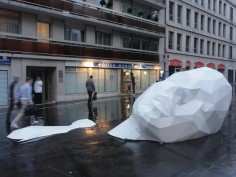DAVID MESGUICH
LUZ 1.0
source: highlike
Work: LUZ 1.0 A public space project by David Mesguich / THE CONTEXT In september 2012 i was invited to do the curatorial of Nuit Blanche in Clichy, a suburbs of Paris. Also i was asked to realise a sculpture in public space. I could complete the work in an historical building call “La Maison du Peuple” “La Maison du Peuple” was build from 1935 to 1938 in the town of Clichy by Marcel Lods, Eugène Beaudouin, Jean Prouvé and Vladimir Bodiansky. This was the first prefabricated building curtain wall and metal frame built in France. La Maison du Peuple de Clichy is both “an architectural gem of the first ring” and “mechanical jewel”. THE SCULPTURE This piece symbolizes the passage from one dimension to another, from concrete to mental world. Trying to overcome physical boundaries. It took me two weeks to made it come to life, alone, it’s all made of polypropylène. Dimensions : 4 X 3m on the ground, 2m height. But first of all Luz 1.0 is dedicated to my daughter Lucie and her mother Anne-Laure. Lucie was born just few weeks before the piece was done in 2012.
Photographer: David Mesguich
.
.
.
.
.
.
source: zupi
O artista David Mesguich, radicado na Bélgica, busca superar os limites físicos com suas enormes esculturas. Essas intervenções urbanas são feitas com folhas de polipropileno ou plástico reciclado e alcançam de 3 metros a 4 metros de altura.
O trabalho de Mesguich fala sobre pessoas que estão em cima do muro, divididas entre o mundo interior e o mundo exterior. As obras que são colocadas em espaço público sem autorização e são um presente para cidade, conta o artista. Crianças escalam essas enormes esculturas que despertam curiosidade e ganham novas dimensões quando o público sente-se envolvido, convidado a interagir.
.
.
.
.
.
.
.
source: ignantde
David Mesguich creates large sculptures made of polypropylene sheets or recycled plastic. The often 3 to 4 meters measuring sculptures are placed in public space. With his latest sculpture ‘Pressure 1.0′, Mesguich tells a story of people who are on the fence, of people in-between worlds, ‘those who are both inside and outside’. His inspiration came from a family history that steeped him in a violent, carceral universe during his youth and the ten years he spent trespassing with graffiti. ‘Pressure 1.0′ was a non-profit sculpture and was similar to his last public space sculpture ‘LUZ 1.0′, created as a donation to the city. With his work the Belgian based artist tries to overcome physical boundaries. By placing ‘Pressure’ in a public space without permission, the unauthorized aspect of placing a piece of work was given a whole new dimension. Passerbyes became more or less involved in the artwork, children would climb it and it aroused curiosity of viewers.
.
.
.
.
.
.
.
source: collateral
David Mesguich crea grandi sculture poligonali realizzate utilizzando fogli e forme di polipropilene o plastica riciclata. Con la sua ultima scultura Pressure 1.0, molto simile al lavoro precedente LUZ 1.0, Mesguich ripensa l’arte urbana invadendo illegalmente il suolo pubblico, e inserendo il suo lavoro tridimensionale di 3-4 metri tra le strade di Marsiglia.
Pressure 1.0 racconta la storia di persone in bilico, ‘those who are both inside and outside’, ispirato in parte alla sua storia familiare e al violento universo carcerario conosciuto durante gli anni della giovinezza.
.
.
.
.
.
.
.
source: etvonwebbe
David Mesguich est un artiste de chez nous, basé à Bruxelles, qui réalise des sculptures géométriques en papier ou plastique recyclé à partir de tracés vectoriels. Ses installations sont monumentales et sa dernière œuvre est un visage féminin de plus de quatre mètres de haut appelé «Luz 1.0», et fût installée dans différents endroits dans Paris. On vous concocterai même peut être une rencontre exclusive prochainement.
.
.
.
.
.
.
.
.
source: mydesy
童話格列佛遊記的第一視角是誤闖小人國的格列佛,那麼如果將視角對換,感覺應該就會像眼前這尊大頭雕像吧!藝術家 David Mesguich 用回收塑料和聚丙烯塑膠打造了超大的人頭雕像,目測約有 3 ~ 4 公尺高的白色頭像,只有大概的輪廓卻沒有五官細節,這樣的設計不是為了省料或者搞噱頭,背後其實有個稍微沉重的淵源故事。如果你問一位藝術家「為何要從事創作」,對方可能會回答「想藉由藝術改變世界」、「反應社會議題」、或者甚至是「沒為甚麼」,但大抵上都是為了表達個人情感,David Mesguich 也不例外,只是他想抒發的這份情緒,卻是源自小時候受到家庭暴力威脅的負面陰影,青少年時期的他,至少有十年的時間,將受到威脅後產生的各種情緒利用塗鴉做為宣洩管道,而這個雕塑,名為《壓力1.0(Pressure 1.0)》,模糊的面像正代表了已然模糊的幼年記憶—雖然已經記不得五官特徵了、但是那股巨大的壓迫感卻是怎麼也忘不掉的!
David Mesguich 也曾用類似的手法做了大型雕塑《LUZ 1.0》,同樣像素化的白色輪廓,斜躺在大馬路上,就像一個正在往下沉的巨人,或許也代表 David Mesguich 認為自己已經從過去的陰暗記憶中解脫的意思。David Mesguich 刻意不申請公開展示的許可,開車載著《壓力1.0(Pressure 1.0)》隨便放在空地上對所有經過的路人「施壓」,他認為這樣的展示方式更能表現整個作品的中心思想,但就目前來說,《壓力1.0(Pressure 1.0)》不僅沒有讓路人產生距離感,反而有些皮小孩還大方地爬上去玩耍,或許看在 David Mesguich 的眼中,這也是一種戰勝陰霾的象徵喔!
.
.
.
.
.
.
.
.
source: offlinehu
Bár általában az olyan utcai alkotások körül szokott nagy hírverés lenni, amik 2D-ben készülnek el, de megfelelő helyről nézve háromdimenziós hatást keltenek, de ettől még a valódi térbeliségnek, vagyis a testeknek is jut hely a street art palettáján. A brüsszeli David Mesguich például újrahasznosított műanyagból alkotgyönyörű, és rendkívül hangulatos installációkat, melyek kapcsán fontos szerep jut az elhelyezésnek is (többnyire illegális helyen, pl. rendőrörs előtt). Meghökkentőek, szokatlanok, miközben nem extrémek, viszont ettől még rendkívül látványosak.
.
.
.
.
.
.
.
.
source: gizmodojp
グラフィティも含むストリートアート。壁や道路に描かれるその形態は常に発展し、動くものやその環境ならではのもの、またプロジェクターで映し出すもの等、多様化してきました。中にはドキュメンタリー映画が制作されたり、ギャラリーでの個展が開かれるアーティストもいます。どんどんアート界での市民権を得ているストリートアートが、また新しい段階へと動いています。今まで平面だったストリートアートがついに3D、立体へ。
ベルギーのブリュッセルを拠点に活動するアーティストDavid Mesguichさんの作品がこちら。ストリートアートの新たな「面」に挑んでいます。彼は、長年グラフィティやアーケードゲームで遊んだ体験が作品のヒントになったと話します。また、刑務所にいる父親とのコミュニケーションも作品に影響を与えていることの1つだそうです。
.
.
.
.
.
.
.
.
source: orogovru
Дэвид Мезгиш создает большие скульптуры из полипропиленовых листов или переработанного пластика, часто от 3 до 4 метров, они идеально вписываются в публичное пространство. Его последняя работа “Давление”, рассказывает историю людей, которые находятся в промежутках между мирами, которые не смогли найти свое место и идут по обочине общества.
.
.
.
.
.
.
.
source: davidmesguich
In a obsessional way David travels cities and develops an atypical mapping by focusing his interest for all which,in those spaces of passage separates and divides up. For more than 10 years it’s by the addicting exercise of graffiti that he investigated the subject. Today, it’s by drawing and by monumental installations in-situ that he re-appropriates some parcels of those aseptic territories.


